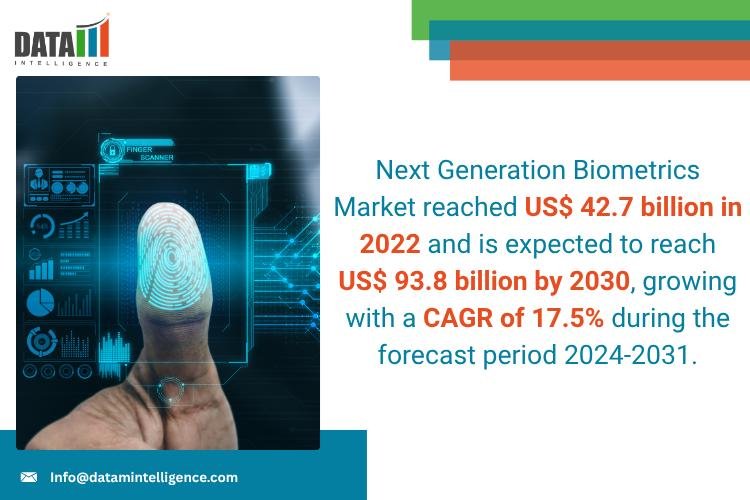Next Generation Biometrics Market reached US$ 42.7 billion in 2022 and is expected to reach US$ 93.8 billion by 2030, growing with a CAGR of 17.5% during the forecast period 2024-2031.
The Next Generation Biometrics Market report by DataM Intelligence provides comprehensive insights and analysis on key market trends, growth opportunities, and emerging challenges. With a commitment to delivering actionable intelligence, DataM Intelligence empowers businesses to make informed decisions and stay ahead of the competition. By combining qualitative and quantitative research methodologies, the firm delivers in-depth reports that help clients navigate complex market dynamics, drive strategic growth, and seize new opportunities in an ever-evolving global landscape.
Download your exclusive sample report today: (corporate email gets priority access): https://datamintelligence.com/download-sample/next-generation-biometrics-market?sg
Next Generation Biometrics Market Landscape Analysis :
Biometric identification systems have become increasingly prevalent due to their precision and ease of use. Commonly used methods include fingerprint scanning, iris recognition, and facial recognition. More recent advancements have introduced vein pattern and DNA recognition as emerging biometric techniques. These technologies offer key advantages such as high accuracy, enhanced privacy, user convenience, and compatibility across multiple platforms. Their unique capabilities support widespread adoption across various sectors, including government, border security, banking and finance, travel, immigration, and defense.
The banking, financial services, and insurance (BFSI) sector has seen significant transformation with the rise of digital technologies. Internet-based financial services and digitized operations are becoming the norm. Many banks are implementing biometric facial recognition to enable secure ATM access, eliminating the need for physical cards. For instance, in May 2022, Mastercard launched a facial recognition-based payment system for in-store transactions, allowing customers to verify payments without relying on smartphones, cards, or PINs.
Regionally, North America is projected to lead the global next-generation biometrics market during the forecast period, accounting for roughly one-third of the total market share. A notable development in the region is the U.S. Army’s launch of the “Next Generation Biometric Collection” program, which aims to capture fingerprint, iris, and advanced facial recognition data using a more compact and portable device-underscoring the growing demand for high-performance, field-ready biometric solutions.
Next Generation Biometrics Market: Shifting Industry Trends and Market Potential
Rising Cybercrime Fuels Demand for Next-Generation Biometric Solutions
The accelerating incidence of cybercrime and global security threats is driving robust growth in the next-generation biometrics market. Heightened concerns around terrorism, data breaches, and identity theft have prompted governments and organizations to invest in more advanced, reliable identification technologies to safeguard sensitive information and ensure national security.
For example, in August 2022, Chile announced plans to deploy an Automated Biometric Identification System (ABIS) aimed at combating organized crime. This system will allow for real-time identification of known criminals, undocumented migrants, and unidentified deceased individuals by integrating biometric data from the civil police (PDI), national civil registry, and Interpol databases.
At the same time, identity fraud continues to surge globally, posing a significant threat to businesses and individuals alike. According to data from Onfido, identity theft rose by 43% year-over-year, with advanced fraud techniques growing by 57%. Criminals are now using increasingly sophisticated methods-such as realistic 2D/3D masks and digital display attacks, including photos or videos used to bypass verification systems.
These developments underscore the critical need for next-generation biometric technologies that can deliver enhanced security, detect spoofing attempts, and adapt to emerging threats in both physical and digital environments.
Make an Enquiry for purchasing this Report @ https://www.datamintelligence.com/enquiry/next-generation-biometrics-market?sg
Strategic Players Driving the Next Generation Biometrics Market Forward: IDEMIA, NEC Corporation, Fujitsu Ltd., Siemens AG, Thales Group, Cross Match Technologies, Fingerprint Cards AB, Suprema Inc, RCG Holdings Ltd. and Safran SA.
Research Methodology:
The global Next Generation Biometrics Market research report employs a comprehensive dual-source approach, integrating both primary and secondary data collection methods to ensure robust market analysis. Our research framework systematically evaluates multiple industry-influencing variables, including regulatory frameworks and government policies, prevailing market conditions, competitive intensity levels, historical performance data, current market positioning, technological innovations and disruptions, emerging industry developments, cross-sector business impacts, market volatility patterns, growth prospects, potential market barriers, and strategic challenges facing industry participants.
Segment Covered in the Next Generation Biometrics Market:
By Type (Face Recognition, Fingerprint Recognition, Iris Recognition, Palm Print Recognition, Signature Recognition, Others)
By Technology (Contact-based, Contactless)
By Application (Government, Defense, BFSI, Home Security, Healthcare, Others)
By Region (North America, Europe, South America, Asia Pacific, Middle East, and Africa)
Stay informed with the latest industry insights-start your subscription now: https://www.datamintelligence.com/reports-subscription?sg
Recent Industry Developments
On September 2022, Onfido, the world’s leading provider of digital identity validation and verification, has introduced Motion, a cutting-edge liveness solution for biometrics that will enhance its Real Identity Platform. Motion is iBeta Level 2 certified and provides seamless, secure and all-inclusive consumer verification.
On August 2022, IDEX Biometrics ASA, a Norwegian biometrics firm and Realtime AS, a major global biometrics developer, have announced a strategic collaboration to develop and commercialize the world’s first Web3 biometric transaction card with cold storing, digital property wallets and digital identities. The market is expected to receive these all-in-one biometrics payment cards that comply with EMV requirements in the first half of 2023.
Regional Analysis for Next Generation Biometrics Market:
⇥ North America (U.S., Canada, Mexico)
⇥ Europe (U.K., Italy, Germany, Russia, France, Spain, The Netherlands and Rest of Europe)
⇥ Asia-Pacific (India, Japan, China, South Korea, Australia, Indonesia Rest of Asia Pacific)
⇥ South America (Colombia, Brazil, Argentina, Rest of South America)
⇥ Middle East & Africa (Saudi Arabia, U.A.E., South Africa, Rest of Middle East & Africa)
Most Frequently Asked Questions in the Next Generation Biometrics Market Research Industry:
➠ Who leads the Next Generation Biometrics industry and what’s their competitive positioning regarding capacity, performance, and profitability?
➠ What growth opportunities and market challenges do Next Generation Biometrics market vendors face?
➠ Which segments show the highest growth potential and market share distribution?
➠ What factors are driving or limiting Next Generation Biometrics market growth?
➠ What are the dominant sales and distribution strategies in the Next Generation Biometrics industry?
Contact Us –
Company Name: DataM Intelligence
Contact Person: Sai Kiran
Email: Sai.k@datamintelligence.com
Phone: +1 877 441 4866
Website: https://www.datamintelligence.com
About Us –
DataM Intelligence is a Market Research and Consulting firm that provides end-to-end business solutions to organizations from Research to Consulting. We, at DataM Intelligence, leverage our top trademark trends, insights and developments to emancipate swift and astute solutions to clients like you. We encompass a multitude of syndicate reports and customized reports with a robust methodology.
Our research database features countless statistics and in-depth analyses across a wide range of 6300+ reports in 40+ domains creating business solutions for more than 200+ companies across 50+ countries; catering to the key business research needs that influence the growth trajectory of our vast clientele.
This release was published on openPR.



















